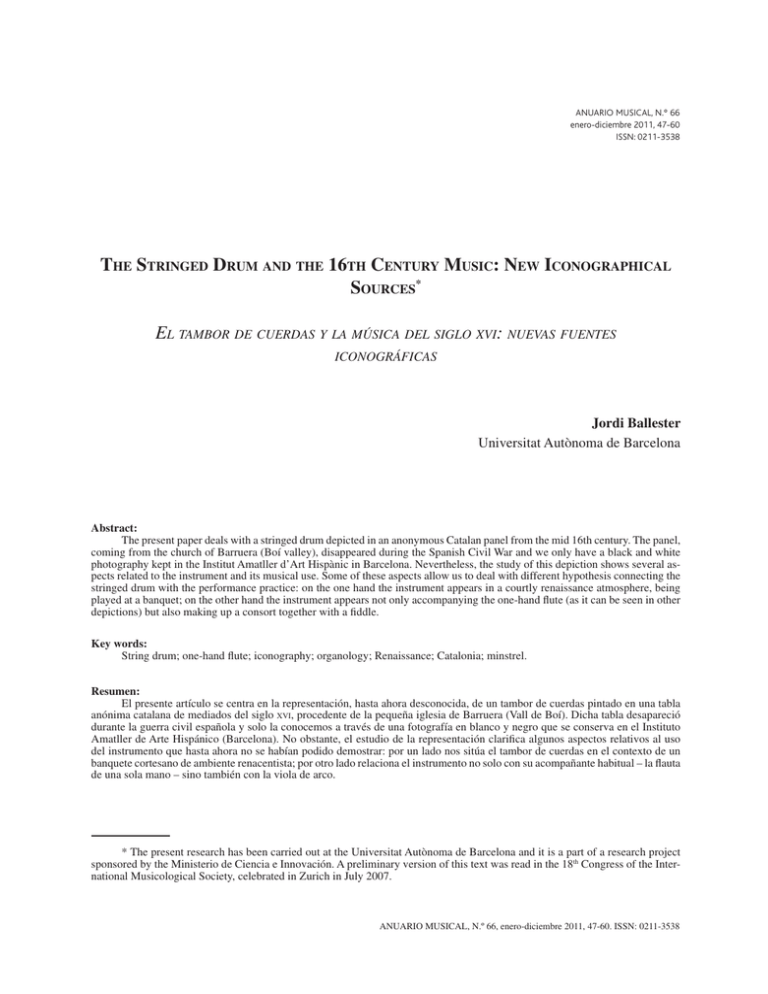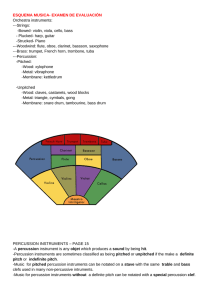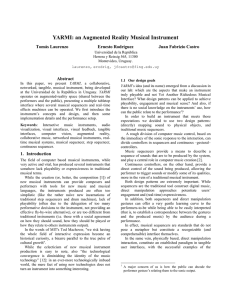The Stringed Drum and the 16th Century Music
Anuncio

ANUARIO MUSICAL, N.º 66 enero-diciembre 2011, 47-60 ISSN: 0211-3538 THE STRINGED DRUM AND THE 16TH CENTURY MUSIC: NEW ICONOGRAPHICAL SOURCES* EL TAMBOR DE CUERDAS Y LA MÚSICA DEL SIGLO XVI: NUEVAS FUENTES ICONOGRÁFICAS Jordi Ballester Universitat Autònoma de Barcelona Abstract: The present paper deals with a stringed drum depicted in an anonymous Catalan panel from the mid 16th century. The panel, coming from the church of Barruera (Boí valley), disappeared during the Spanish Civil War and we only have a black and white photography kept in the Institut Amatller d’Art Hispànic in Barcelona. Nevertheless, the study of this depiction shows several aspects related to the instrument and its musical use. Some of these aspects allow us to deal with different hypothesis connecting the stringed drum with the performance practice: on the one hand the instrument appears in a courtly renaissance atmosphere, being played at a banquet; on the other hand the instrument appears not only accompanying the one-hand flute (as it can be seen in other depictions) but also making up a consort together with a fiddle. Key words: String drum; one-hand flute; iconography; organology; Renaissance; Catalonia; minstrel. Resumen: El presente artículo se centra en la representación, hasta ahora desconocida, de un tambor de cuerdas pintado en una tabla anónima catalana de mediados del siglo XVI, procedente de la pequeña iglesia de Barruera (Vall de Boí). Dicha tabla desapareció durante la guerra civil española y solo la conocemos a través de una fotografía en blanco y negro que se conserva en el Instituto Amatller de Arte Hispánico (Barcelona). No obstante, el estudio de la representación clarifica algunos aspectos relativos al uso del instrumento que hasta ahora no se habían podido demostrar: por un lado nos sitúa el tambor de cuerdas en el contexto de un banquete cortesano de ambiente renacentista; por otro lado relaciona el instrumento no solo con su acompañante habitual – la flauta de una sola mano – sino también con la viola de arco. * The present research has been carried out at the Universitat Autònoma de Barcelona and it is a part of a research project sponsored by the Ministerio de Ciencia e Innovación. A preliminary version of this text was read in the 18th Congress of the International Musicological Society, celebrated in Zurich in July 2007. ANUARIO MUSICAL, N.º 66, enero-diciembre 2011, 47-60. ISSN: 0211-3538 48 JORDI BALLESTER Palabras clave: Tambor de cuerdas; flauta; iconografía; organología; renacimiento; Cataluña; ministril. The Institut Amatller d’Art Hispànic, in Barcelona, keeps in its archive the photograph of a 16th century anonymous panel depicting the Feast of Herod and the Decapitation of Saint John the Baptist (fig. 1)1. The photo was taken in 1922 in the church of Barruera, a little village located in the Boí valley, in the Catalan Pyrenees. Unfortunately the panel disappeared some years after the photo was taken, presumably destroyed during the Spanish Civil War. Thus, this black and white photograph is the only remaining evidence of the picture. Figura 1. The Fest of Herod and the Decapitation of Saint John the Baptist, 16th century anonymous panel which disappeared during the 20th century. Photo taken in 1922 in the church of Barruera (Boí valley, Catalan Pyrenees) [Photo: Institut Amatller]. 1 See BALLESTER, Jordi: “Inventaire de peintures catalanes du XVIe siècle à sujets musicaux” Musique-Images-Instrumets , 7 (2005), pp. 196-220; see entry n. 51 in p. 214. ANUARIO MUSICAL, N.º 66, enero-diciembre 2011, 47-60. ISSN: 0211-3538 THE STRINGED DRUM AND THE 16TH CENTURY MUSIC: NEW ICONOGRAPHICAL SOURCES 49 The painting shows a very well known scene related to Saint John’s death. In fact, the devotion to the Baptist generated all around Europe a big amount of artistic worship objects, mainly altarpieces, especially abundant from the 14th century onwards2. The iconographical program of such altarpieces usually places an image of Saint John in the central panel, whereas several lateral compartments narrate the events of his story. It is among these scenes that we normally find the Feast of Herod and the Decapitation of Saint John, both inspired by the Gospel texts (Matthew 14:1 and Mark 6:14): On Herod’s birth-day the daughter of Herodias danced for them and pleased Herod so much that he promised to give her whatever she asked; prompted by her mother she asked the head of John the Baptist, and Herod ordered that her request be granted and had John beheaded in the prison. According to late-medieval artistic trends, painters used to incorporate characters and objects to these scenes that contributed to place the action in a contemporary atmosphere. Thus, it was usual to include furniture, architectural elements, musicians or musical instruments inspired in the contemporary world. In any case, it is obvious that our painter followed this well-established iconographical tradition and assumed the 15th century pictorial models: we can see Salome in the foreground, receiving Saint John’s severed head from the hands of the executioner and, behind them, there is the banquet with the King Herod and Herodias on the right, a servant in the center, and two musicians on the left. Certainly the picture calls one’s attention for its rough simple old-fashioned style, but in fact most Catalan paintings of the 16th century follow this late Gothic pattern under the influence of the central and north European taste, far from the modern concept of perspective and the new artistic ideas coming from Italy3. Nevertheless, it is beyond doubt that the artist wanted to place the action in a Renaissance courteous context: he is really precise, for instance, in dressing all the characters in typical mid-16th century clothes, and in depicting fashionable beards, moustaches and women headdresses. It is in this context that the two musicians become relevant: one playing a fiddle and the other playing a pipe and a six-stringed drum. As far as I know, this is the earliest depiction of a minstrel playing the string drum in a courteous atmosphere. Certainly the history of the string drum goes several centuries back. Curt Sachs, in his History of Musical Instruments, points out that the origins of the instrument date from the 12th century4 and the Spanish musicologist Josep M. Lamaña goes two hundred years back and asserts, without any documental evidence, that the string drum was already depicted in the 10th century5. But, as my Spanish colleague Rosario Álvarez stated, it is only from the beginning of the 14th century onwards that we have enough literary, archival and iconographical documents to define this instrument accurately6. 2 The large number of 14th and 15th century altarpieces devoted to Saint John we find in the ancient kingdom of Aragon, suggests a great popular devotion to the saint in this country. See BALLESTER, Jordi: “Saint John the Baptist, Salome, and the Feast of Herod: three pictorial subjects related to musical iconography in the kingdom of Aragon in the 14th and 15th centuries” RIdIM/ RCMI Newsletter 20/1 (1995), pp. 29-36. 3 GARRIGA, Joaquim: “Paisatge en reconstrucció: la pintura a Catalunya entorn de 1519” in L’art a Catalunya i els regnes hispans en temps de Carles I. Madrid, Sociedad Estatal para la Conmemoración de los Centenarios de Felipe II y Carlos V, 2000, p. 143-163; and BALLESTER, Jordi: “Music in the 16th century Catalan painting” Music in Art, 31/1-2 (2006), pp. 132-142. 4 See SACHS, Curt: Historia Universal de los Instrumentos Musicales. Buenos Aires, Centurión, 1947, p. 277. 5 See LAMAÑA, José Mª: “Los instrumentos musicales en la España renacentista” Miscellanea Barcinonensia 39 (1974), pp. 67-117. 6 See ÁLVAREZ, Rosario: “El dicordio percutido (Chorus) en la iconografía bajomedieval” in Campos interdisciplinares de la musicología II. Madrid: Sociedad Española de Musicología, 2001, pp. 1243-1256. ANUARIO MUSICAL, N.º 66, enero-diciembre 2011, 47-60. ISSN: 0211-3538 50 JORDI BALLESTER Effectively, there are several but rather scarce 14th, 15th and 16th century depictions of string drums around Europe, especially in France, the Low Countries, Italy and the Iberian Peninsula. Nevertheless, the instrument is usually held by angel musicians or, exceptionally, by the Apocalypse elders or by cherubic figures7. In fact, at least three of these early depictions come from Catalonia and confirm that the instrument was known in that country – at the very least from the iconographical point of view – more than a hundred years before our Feast of Herod was depicted. It is worth noting however, that some of these Catalan string drum depictions show a primitive kind of instrument distinguished for having only two strings. In such cases, the musician uses to beat it using two sticks, one in each hand (without playing any pipe simultaneously). Rosario Álvarez devoted her article precisely to this kind of two-stringed drum; she calls it dicordio percutido or chorus, and she states that this device may be considered the ancestor of the string drum properly speaking. This is exactly what we can see, for example, in the terracotta vault of the Palau Dalmases chapel, in Barcelona (fig. 2)8. Figura 2. Angel playing the string drum (first quarter of the 15th century) in the anonymous terracotta vault of the Palau Dalmases chapel (Barcelona) [Photo: Author]. 7 On the string drum and its relation to the Apocalypse elders see ÁLVAREZ, Rosario: “El dicordio ...”, op. cit. , p. 1249; and by the same author, “Los instrumentos musicales del Apocalipsis figurado de los Duques de Saboya: entre el símbolo y la realidad”, Nasarre V/2 (1989), p. 57. With regard to string drums played by cherubic figures see GASTELLU, Marcel: “Le ttun-ttun et la xirula dans l’iconographie de la flûte a trois trous et du tambourin a cordes a la Renaissance, en Espagne, Italie et Portugal”, Pastel: Trimestriel regional des musiques traditionnelles, 11 (1992), pp. 18-24. 8 The extraordinary ensemble of musical instruments carved in the vault of the Palau Dalmases chapel were studied for the first time by LAMAÑA, José Mª: “Estudio de los instrumentos musicales en los últimos tiempos de la dinastía de la Casa de Barcelona” Miscellanea Barcinonensia, XXI (1969), pp. 21-82 and XXII (1969), pp. 43-64. Nevertheless, Lamaña confused the string drum with a bowed tromba marina, see vol. XXI, p. 52. ANUARIO MUSICAL, N.º 66, enero-diciembre 2011, 47-60. ISSN: 0211-3538 THE STRINGED DRUM AND THE 16TH CENTURY MUSIC: NEW ICONOGRAPHICAL SOURCES 51 In this anonymous work from the first quarter of the 15th century, the instrument is so long that its lower end would rest on the floor if the angel musician wasn’t flying in a heavenly atmosphere! Moreover, the upper end of the box clearly rests on the left shoulder of the angel, giving enough freedom to both arms to move quickly and to beat the strings accurately at different points of the instrument. A similar drum in shape and length, but beaten only with one hand, is the one carved in the stone altarpiece from Castelló de Farfanya (Lleida) during the second half of the 14th century (fig. 3). Figura 3. Angel playing the string drum (second half of the 14th century) in the anonymous stone altarpiece of the parish church of Castelló de Farfanya (La Noguera, Lleida). Photo taken in 1914. [Photo: Institut Amatller]. It is, in fact, the oldest Catalan depiction preserved of a string drum. Unfortunately, this altarpiece – which was already damaged at the beginning of the 20th century, as we can see in the 1914 photography preserved in the Institut Amatller d’Art Hispànic in Barcelona – suffered later aggressions and nowadays the bottom part of the instrument is lost. Anyway, such kind of instrument is presumably the one referred in the 14th and 15th centuries by authors as Jean LeFèvre de Ressons (c.1320-c.1380), Aymeric de Peyrac (c.1340-1406) or Jean de Gerson (1363-1429). To this respect, Jean de Gerson is very precise when he asserts that the term chorus “is ANUARIO MUSICAL, N.º 66, enero-diciembre 2011, 47-60. ISSN: 0211-3538 52 JORDI BALLESTER applied by some people to a certain oblong, hollow instrument in the form of a beam, having two or three strings much thicker than those of the cithara, which when diversely struck with sticks give a rude sound”9. But this kind of string drum is quite different from the one depicted in the Feast of Herod panel. A close look at this instrument shows us that despite consisting of a long rectangular box, with two round soundholes opened on the soundboard surface, it has no less than six strings stretched from top to bottom (fig. 4). Figura 4. Musicians in The Fest of Herod. Detail of fig. 1. Given the fact that the instrument runs from the musician’s chest to his knees, and that it is shown slightly sidewise, we can assume that the box is no less than 85/90 cm long, around 20 cm in width and 15 cm in depth. The minstrel is striking all the strings simultaneously with a stick held in the right hand, meanwhile the left hand holds a long slender cylindrical pipe presumably with holes for two fingers and thumb. Broadly speaking, this kind of stringed drum coincides with the instrument still used nowadays in some Pyrenean areas as the Basque country, Navarre, Gascony and the north of Aragon, and known as tun-tun, bertz, soinua, toutouna, tambourin de Béarn, tambourin de Gascogne, chicotén or salterio10. 9 See PAGE, Christopher: “Early 15th century instruments in Jean de Gerson’s Tractatus de Canticis”, Early Music 6 (1978), pp. 339-349. The original text of Gerson says: “Chorus vocatur a nonnullis vulgaribus instrumentum quoddam instar trabis oblongum et vacuum, chordas habens grossiores multo plus quam cithara duas aut tres, quae baculis erutis percussae varie variant rudem sonum”. See also MARCUSE, Sybil: A survey of Musical Instruments. London, David & Charles, 1975, p. 200-202. 10 For a basic definition of this instrument see MONTAGU, Jeremy: “Was the Tabor Pipe always as we know it?”, The Galpin Society Journal, 50 (1997), pp. 16-30. On note 2 Montagu states: “In Navarre and Bayonne a string drum, known by various names ANUARIO MUSICAL, N.º 66, enero-diciembre 2011, 47-60. ISSN: 0211-3538 THE STRINGED DRUM AND THE 16TH CENTURY MUSIC: NEW ICONOGRAPHICAL SOURCES 53 In fact, the earliest depictions of these multiple-stringed drums associated to a pipe date from the second half of the 15th century. It is well known, for instance, the instrument played by an angel in the Assumption of the Virgin depicted around 1488-1493 by Filippino Lippi (1457-1504) in the Capella Carafa of Santa Maria sopra Minerva church, in Rome (fig. 5)11. Figura 5. Angel playing the string drum in the Assumption of the Virgin (1488-1493) by Filippino Lippi (1457-1504) in the Capella Carafa of Santa Maria sopra Minerva church (Rome) [Photo: Author]. Here the drum has only three strings and the outline of the box is quite different from the Catalan one, but the likeness between the three-holed pipes are worthy of remark: the length, the inclination and even the position of the left hand fingers are basically the same in both depictions. On the contrary, there are similarities between our Feast of Herod string drum and the shape and general appearance (including the two sound holes opened on the surface) of the string drum depicted around 1535 by Gaudenzio Ferrari (c. 1471-1546) in the vault of Santa Maria dei Miracoli sanctuary in Saronno, near Milan (fig. 6). such as tsountsounia, ttun-ttun, tambourin de Béarn, and which is technically a box zither, is played as though it were a drum, with six or more strings tuned some to the tonic and some to the dominant of the pipe, and it is used instead of a normal drum. There is iconographic evidence for its existence continuously from the Middle Ages”. 11 See GARNAULT, Paul: “Le tambourin a cordes des Pays Basques”, Revue de Musicologie, 11 (1930), p. 282. ANUARIO MUSICAL, N.º 66, enero-diciembre 2011, 47-60. ISSN: 0211-3538 54 JORDI BALLESTER Figura 6. Angel playing the string drum by Gaudenzio Ferrari (c. 1471-1546) in the vault (1535) of Santa Maria dei Miracoli sanctuary in Saronno [Photo: Author]. Also very similar is the six stringed instrument depicted before 1494 by the Milanese illuminator Giovan Pietro Birago (doc. 1471-1513) in the Sforza Book of Hours, nowadays in the British Library (Add. Ms. 34294, f.36v), among other Italian examples12. In the Iberian Peninsula we have another interesting and not very well known example: the rectangular, but shorter, five-stringed instrument carved around 1514 in the wood altarpiece of the parish church of Santa Maria de la Asunción in Lekeitio (Vizcaya, Basque country) (fig. 7)13. 12 See LAZZARONI, Luigi, et alii: Il concerto degli angeli. Gaudenzio Ferrari e la cupola del Santuario di Saronno. Milan, Silvana, 1994. For South Italian sculptural examples see FABRIS, Dinko: “Presepi scultorei con strumenti musicali del cinquecento in Puglia”, RIdIM/RCMI Newsletter, 16/1 (1991), pp. 8-20. 13 I am grateful to Koldo Rios for letting me know of the existence of this altarpiece and for sending me the photograph. ANUARIO MUSICAL, N.º 66, enero-diciembre 2011, 47-60. ISSN: 0211-3538 THE STRINGED DRUM AND THE 16TH CENTURY MUSIC: NEW ICONOGRAPHICAL SOURCES 55 Figura 7. Angel playing the string drum in the anonymous wood altarpiece (1514) of the parish church of Santa Maria de la Asunción in Lekeitio (Vizcaya, Basque country) [Photo: Koldo Rios]. It is worth noting that in this Basque depiction no pipe can be seen, but it is just due to the fact that the angel musician’s left hand was broken and lost. In Catalonia, as far as I know, we can only find another depiction of this kind of multiple-strings drum prior to the one of the Feast of Herod14. It can be seen in an anonymous panel attributed to Javierre master and devoted to Saint Vincent15. The panel, nowadays preserved in the Museu de Lleida Diocesà i Comarcal, was painted between 1487 and 1506 for the church of Fontdepou in Àger (La Noguera, Lleida), a little village located a few kilometres south of the Boí valley (very near Castelló de Farfanya where the stone altarpiece with the oldest Catalan depiction of a stringed drum already mentioned is located). In this painting we can see Saint Vincent on a throne surrounded by six angel musicians. One of the angels clearly beats the string drum and blows the pipe (fig. 8). 14 Other Iberian images can be seen in GASTELLU, Marcel: “Le ttun-ttun et la xirula …” op. cit., fig. 4 to 9. 15 See BALLESTER, J.: “Inventaire de peintures …”, op. cit., entry n. 15 in p. 203. ANUARIO MUSICAL, N.º 66, enero-diciembre 2011, 47-60. ISSN: 0211-3538 56 JORDI BALLESTER Figura 8. Angel playing the string drum; detail of the altarpiece of Saint Vincent, painted by Master of Javierre between 1487 and 1506 for the church of Fontdepou in Àger (La Noguera, Lleida). Museu de Lleida Diocesà i Comarcal. [Photo: Institut Amatller]. Nevertheless, the drum appearance here is rather different due to its amazing and prominent pegbox, and because of its larger and exceptional number of strings and pegs: around ten pegs are inserted in the pegbox and the same number of strings runs over the soundboard. In any case, these examples show that the multiple stringed drum was well known from the end of the 15th century onwards. Moreover, the popularity of the instrument during the Renaissance in the Iberian Peninsula is also attested by one of the first Spanish dictionaries published in Madrid in 1611: the Tesoro de la lengua castellana o española by Sebastián de Covarrubias y Orozco (1539-1613). Covarrubias uses the term salterio to designate the string drum, a word that could certainly be confused (even in Spanish) with the plucked psaltery; nonetheless, as I pointed out, this term is still used nowadays in some areas of Aragon to refer to the string drum16. Thus, according to Covarrubias: 16 Covarrubias definition was quoted to for the first time by José Mª Lamaña precisely to link the word salterio to the string drum. See LAMAÑA: “Los instrumentos musicales …”, op. cit., pp. 110-111. The passage is also quoted by ÁLVAREZ, Rosario: “El dicordio percutido ...”, op. cit., pp. 1251. ANUARIO MUSICAL, N.º 66, enero-diciembre 2011, 47-60. ISSN: 0211-3538 THE STRINGED DRUM AND THE 16TH CENTURY MUSIC: NEW ICONOGRAPHICAL SOURCES 57 “El instrumento que agora llamamos salterio es un instrumento que tendrá de ancho poco más que un palmo, y de largo una vara17, hueco por dentro, y el alto de las costillas de cuatro dedos; tiene muchas cuerdas, de alambre, y concertadas de suerte que tocándolas todas juntas con un palillo guarnecido de grana hace un sonido apacible; y su igualdad sirve de bordón para la flauta que el músico deste instrumento tañe con la mano siniestra, y conforme al son que quiere hazer, sigue el compás con el palote; úsase en las aldeas, en las procesiones, en las bodas, en los bayles y danças”18. It is this kind of multiple stringed drum which – with different outlines – came into fashion in the French court circles at the beginning of the 18th century. Following a vogue for the pastoral, the instrument was included in some operas – just to give an exotic touch –, participated in courtly dances and inspired musical pieces featuring bass drones. Moreover, during this period the instrument was depicted in country scenes in which the musician accompanies sophisticated courtly dressed peasants. Some of the best examples of it can be seen, for instance, in the works of Nicolas Lancret (1690-1743) or François Boucher (1703-1770), among others. A very good example can be seen, for example, in a tapestry from c. 1750 depicting The Dance and based on a painting by Boucher; this tapestry, kept in the Metropolitan Museum of Art in New York, takes part from the series Les Fêtes Italiennes. But as Florence Gétreau pointed out in an article devoted to the tambour-bourdon in France, we can’t forget that the string drum or tambourin de Gascogne et de Béarn remained steadily in use in some areas of the Pyrenees and the southwest of France. What is more, it seems that during the 17th and 18th centuries, the instrument was used there not only in popular contexts but also in aristocratic ones19. It is precisely this reference to aristocratic contexts and the traditional use of the string drum in dances, processions and weddings mentioned by Covarrubias, that takes me back to the 16th century Feats of Herod panel. As I pointed out at the beginning of this article, this is the earliest depiction I know in which the string drum is played by a minstrel in a courtly atmosphere20. Far from the usual heavenly contexts in which the angels play their celestial music, this earthly scene suggests a real musical practice and consequently it is one of the first depictions showing the string drum used in a mid 16th century banquet – by the way, a situation that perfectly could fit in a wedding occasion as the one described by Covarrubias. It is also worth remembering that, according to the Gospel texts, it was in the Feast of Herod where the young Salome danced and pleased him. Certainly, our depiction places us after Salome’s 17 The vara is an ancient Spanish measure equivalent to 835 millimetres and 9 tenth. 18 COVARRUBIAS, Sebastián de: Tesoro de la lengua castellana o española. Madrid, Luís Sánchez, impresor del Rey, 1611 / revised and edited by Martín de Riquer, Barcelona, Alta Fulla, 1987, p. 922. 19 See GÉTREAU, Florence: “Tambours-bourdons en France au XVIIIe siècle”, Musique-Images-Instruments, 7 (2005), pp. 66-85. 20 There is a late 16th century Italian reference that corroborates the existence of the stringed drum in a courtly context: the 1592 inventory of the Marquis Ferdinando d’Alarçon, descendant from an aristocratic Spanish family, which includes “Due veste di Bottafoco” (two cloth bags of a Buttafuoco – Italian name for the string drum). See MAMMARELLA, Alberto: “Musical Insruments in a 1592 Inventory of the Marquis Ferdinando d’Alarçon”, The Galpin Society Journal, 59 (2006), pp. 187-205. ANUARIO MUSICAL, N.º 66, enero-diciembre 2011, 47-60. ISSN: 0211-3538 58 JORDI BALLESTER performance, but we can easily assume that they are the same musicians who have just accompanied the dancer. In fact, it is reasonable to think that the painter wanted to place the 16th century viewers before a consort of instruments they could link, among other musical practices, to some dances they knew. Thus, the scene implies not only a festive banquet but also the dances carried out in such occasions accompanied by the sound of the string drum21. In this sense, our Feast of Herod becomes an evidence of Covarrubias statement about the use of the instrument in dances and other festivity circumstances. A statement that also leads us to the Pyrenean popular traditions in which the string drum is still used in such occasions. In Jaca (Alto Aragon), for instance, the string drum called chicotén supplies the music for the dancers on the day of Santa Orosia, June 25th. And in the French Basque province of Soule, the tun-tun may be heard at rustic parties, weddings and a kind of Masquerades performed in Easter time22. It is true that our panel doesn’t come from any of these Pyrenean areas in which the string drum has remained until now but, according to the iconographical sources and the Covarrubias words, it is very probable that the use of this instrument was quite common all around the Iberian Peninsula during the 14th, 15th and even the 16th century. Actually, even if it wasn’t the case, we must note that the Boí valley (where our panel was placed) is really close to the Alto Aragon area, so it would have been easy for Aragonese musicians and painters to reach the Catalan valley. Finally, it is also interesting to go over the whole musical ensemble depicted in our Feast of Herod panel: string drum, pipe and fiddle. A consort traditionally associated with folk and dance music that, as far as I know, is shown in several paintings at least from the end of the 16th century onwards. A very good iconographical example is the one depicted between 1598 and 1605/6 in the chapel of the Real ColegioSeminario de Corpus Christi (in Valencia) by the Genoese painter, resident in Spain, Bartolomé Matarana (c.1550-1605/6) (fig. 9)23. Nevertheless, the players here – as in the majority of depictions – are angel musicians again. So, the minstrels of the Feast of Herod become relevant once again, giving one of the scarce evidences of a performance with such instruments in an earthly context. 21 As far as I know, there is only a depiction of a string drum that has been linked to real practice until now: it is the image of a child / cherub playing the string drum and the pipe in a chariot carved in the Choir of the El Pilar cathedral in Zaragoza. According to GASTELLU, Marcel: “Le ttun-ttun et la xirula …”, op. cit., pp. 21-22, fig. 7, this depiction shows a theatrical chariot which suggests the pastoral / theatrical performances traditionally carried out in the Basque region of Soule. Moreover, Gastellu points out certain symbolical links between this kind of depictions and some sorcery rituals in which the string drum could have taken part in. 22 See ALFORD, Violet: “Some Notes on the Pyrenean Stringed Drum”, Revista Internacional de Estudios Vascos (RIEV), 26 (1935), pp. 567-577. 23 See OLSON, Greta J.: “Angel Musicians, Instruments and Late-Sixteenth-Century Valencia (Spain)”, Music in Art, 27/12 (2002), pp. 46-67. ANUARIO MUSICAL, N.º 66, enero-diciembre 2011, 47-60. ISSN: 0211-3538 THE STRINGED DRUM AND THE 16TH CENTURY MUSIC: NEW ICONOGRAPHICAL SOURCES 59 Figura 9. Angel playing the string drum in the chapel of the Real Colegio-Seminario de Corpus Christi in Valencia (depicted between 1598 and 1605/6) by Bartolomé Matarana (c.1550-1605/6) [Photo: Author]. To conclude, the Feast of Herod and Decapitation of Saint John the Baptist panel shows us an uncommon depiction of a string drum which allows us to discuss on the instrument, to speculate about its uses, and to confirm the kind of ensembles in which it was already involved in mid16th century. Recibido: 03/11/2010 Aceptado: 03/06/2011 ANUARIO MUSICAL, N.º 66, enero-diciembre 2011, 47-60. ISSN: 0211-3538





